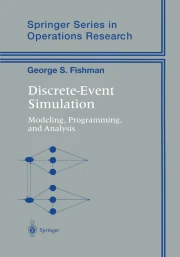
This is a preview of subscription content, log in via an institution to check access.
Softcover Book EUR 105.49
Price includes VAT (France)Hardcover Book EUR 105.49
Price includes VAT (France)Tax calculation will be finalised at checkout
Discrete-event simulation consists of a collection of techniques that when applied to a discrete-event dynamical system, generates sequences called sample paths that characterize its behavior. The collection includes modelling concepts for abstracting the essential features of a system, using specially designed software for converting these relationships into computer executable code capable of generating the requisite sample-path data; outlining procedures for converting these data into estimates of systems performances; and then illustrating methods for assessing how well these estimates approximate true, but unknown system behavior.
This book is intended for upper level undergraduate and graduate students in operations research and management science, mathematics, industrial engineering, computer science, and business and features extensive exercises throughout. This concept of modelling complex sytems allows a relatively low-cost way of gathering information for decision-making.
Principally offered are four problems for student exercises; each is progressively brought forward through the modelling, programming, and analysis chapters, providing continuity to the learning process.
From the reviews:
"This is an excellent and well-written text on discrete event simulation with a focus on applications in Operations Research. There is substantial attention to programming, output analysis, pseudo-random number generation and modelling and these sections are quite thorough. Methods are provided for generating pseudo-random numbers (including combining such streams) and for generating random numbers from most standard statistical distributions."
ISI Short Book Reviews, Vol. 22/2, August 2002
"This 537-page book is primarily a text to support the teaching of discrete-event simulation for post-graduates and final-year undergraduates. . The book is a reasonably full, theory based, introduction to the technique of discrete-event simulation. Fishman’s earlier texts (1973 and 1978) established themselves as common points of reference and this book is likely to join them. It is worth considering as a course text or as a reference work for simulation users, and certainly as a worthwhile addition to relevant libraries." (B. Hollocks, Journal of the Operational Research Society, Vol. 54, 2003)
"This book is a comprehensive text and reference for simulation of continuous-time processes that change state only at discrete, typically random, times. . The coverage is substantial . . there is considerable detail on simulating particular kinds of interevent distributions and reasonable attention to interpretation and statistical analysis of simulation output . . The SIM-SCRIPT programming language is used to illustrate specific techniques." (Alan F. Karr, Journal of the American Statistical Association, December, 2002)
"Besides the good choice of material of the book and its clear and excellent methodological presentation the referee has . to stress on two points that distinguish Fishman’s book positive from others. One is that each chapter finishes with three subchapters – lessons learned,(interesting) exercises, and (actual and voluminous) references. The second one is that the book contains a multitude of accessible through the internet software sources. . Fishman’s book can be highly recommended for practitioners as well as for students and simulation specialists." (P. Köchel, Operations Research-Spektrum, Issue 17, 2003)
"This is an excellent and well-written text on discrete event simulation with a focus on applications in Operations Research. There is substantial attention to programming (largely in SIMSCRIPT II.5), output analysis, pseudo-random number generation and modelling and these sections are quite thorough. . a text that is accessible, coherent and readable on those topics of major interest to ‘simulationists’ in the management and engineering sciences." (D. L. McLeish, Short Book Reviews, August, 2002)
"This book covers the whole life cycle of the discrete-event simulation process . . the author gives an excellent and complete introduction to all aspects related to discrete-event computer simulation. . this book is highly recommendable either to be used as a text for a course on discrete-event simulation or as a reference for discrete-event simulation, as it provides a balance between theoretical and practical issues, including coding in different simulation languages and plentiful examples which are well developed throughout the book." (Juan de Lara Jaramillo, Journal of Artificial Societies and Social Simulation Vol. 5 (3), September, 2002)
"Since students often learn about discrete-event simulation through particular software’s modelling, sampling, analysis and reporting capabilities, their skills for overcoming impediments may be severely limited unless they are well versed in the basic concepts of discrete-event simulation. . This book supplies a mean for providing the needed background. It gives relatively detailed account of the principal methodologies of discrete-event simulation. At the end of nearly all chapters are exercises, which are well described." (Barbara Pototschnig, Simulation News Europe, Issue 34, 2002)
"Once a simulation procedure is adopted, one must apply the simulation techniques interactively with the adaptation of the modelling techniques . . In this context the book is a valuable basis for acquiring the necessary skills . . The book is highly recommended as an introductory course for graduate and advanced undergraduate students in the mathematical and engineering sciences, particularly operations research, industrial engineering, operations management . and to the professionals in these fields who are interested to broaden their knowledge of discrete-event simulation." (Mihail Voicu, Zentralblatt MATH, Vol. 973, 2001)